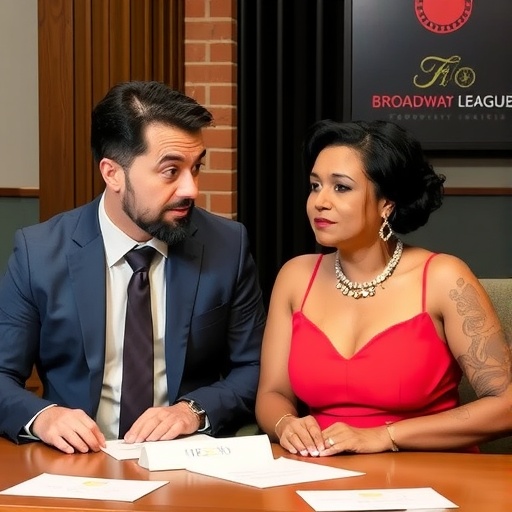Breakthrough in Broadway Labor Talks Ends Months of Uncertainty
In a dramatic turn that has the theater world buzzing, the Broadway League and Actors’ Equity Association have finalized a tentative labor agreement after more than six months of intense, marathon negotiations. This development, announced late Thursday evening, comes as a much-needed relief to an industry still reeling from the impacts of the COVID-19 pandemic and subsequent labor tensions. The agreement, if ratified by union members, promises to stabilize Broadway’s workforce and pave the way for a robust return of productions in the coming seasons.
- Breakthrough in Broadway Labor Talks Ends Months of Uncertainty
- Marathon Negotiations: Key Flashpoints and Hard-Won Compromises
- Unpacking the Tentative Labor Agreement: Wages, Safety, and Beyond
- Industry Reactions: Relief, Optimism, and Lingering Concerns
- Path Forward: Ratification Process and Broadway’s Revival Horizon
The negotiations, which began in earnest last spring, were marked by heated debates over wages, health and safety protocols, and working conditions in an era of heightened awareness around performer protections. Sources close to the talks revealed that the final sessions stretched over 72 hours, with mediators working around the clock to bridge the gap between producers’ budgetary constraints and actors’ demands for fair compensation and security. “This is a pivotal moment for Broadway,” said Kate Shindle, president of Actors’ Equity, in a statement released shortly after the announcement. “Our members have shown incredible resilience, and this deal reflects their vital contributions to the art form we all cherish.”
The Broadway League, representing more than 700 theaters and producers across North America, echoed this sentiment. Charlotte St. Martin, the League’s president, noted, “Reaching this agreement demonstrates our shared commitment to the future of live theater. It’s a testament to the collaborative spirit that defines our industry.” This labor agreement is seen as a cornerstone for theater news this year, potentially averting strikes that could have further disrupted New York’s iconic Great White Way.
To understand the significance, it’s essential to contextualize the broader landscape. Broadway has been in recovery mode since March 2020, when performances halted abruptly due to the pandemic. The industry lost an estimated $15 billion in revenue during the shutdown, according to a report from the New York State Comptroller’s office. Post-reopening in September 2021, challenges persisted, including supply chain issues for sets and costumes, rising operational costs, and a talent pool strained by two years of unemployment. Actors’ Equity, with over 51,000 members, has been vocal about ensuring that the resurgence doesn’t come at the expense of performer welfare.
Statistics underscore the stakes: In the 2022-2023 season, Broadway saw 36 new productions, a 20% increase from the previous year, but attendance hovered at 80% of pre-pandemic levels, per data from The Broadway League. Ticket sales reached $1.2 billion, yet many shows operated at a loss due to inflated labor and production expenses. This tentative deal addresses these pain points head-on, incorporating adjustments that could boost profitability while safeguarding actors’ rights.
Marathon Negotiations: Key Flashpoints and Hard-Won Compromises
The path to this tentative labor agreement was anything but smooth, fraught with flashpoints that tested the resolve of both the Broadway League and Actors’ Equity. Negotiations kicked off in April 2023, initially focused on updating the 2019 Production Contract, which governs principal roles in Broadway shows. Early sticking points included minimum salary increases, with actors pushing for a 15% hike to keep pace with New York City’s soaring cost of living—where median rent for a one-bedroom apartment now exceeds $3,500 monthly, according to Zillow data.
Producers, represented by the Broadway League, countered with offers closer to 8-10%, citing the financial fragility of many theaters. “We had to balance artistic ambition with economic reality,” explained one anonymous League negotiator. Health and safety emerged as another battleground, especially after high-profile COVID outbreaks during rehearsals for shows like Hamilton and The Lion King. Actors’ Equity demanded enhanced protocols, including mandatory ventilation upgrades in aging venues like the Lyceum Theatre and comprehensive mental health support amid the stresses of live performance.
By July, talks had stalled, leading to public demonstrations outside the Winter Garden Theatre, where over 200 Equity members rallied for better contracts. Social media amplified their voices, with hashtags like #EquityStrong trending on Twitter, garnering millions of impressions. The intervention of federal mediators in September proved crucial, facilitating private sessions that delved into data-driven arguments. For instance, Equity presented studies showing that actor turnover rates had spiked 25% since 2020, per a union-commissioned survey, linking it to inadequate benefits.
Compromises were forged in the final weeks. The tentative deal reportedly includes a tiered wage scale: a 12% increase for principal actors in the first year, escalating to 18% over three years, alongside bonuses tied to box office performance. Health provisions mandate employer-funded insurance covering therapy sessions and ergonomic assessments for performers prone to repetitive strain injuries. “These aren’t just numbers on a page; they’re lifelines for our community,” Shindle emphasized in an interview with Playbill magazine.
Behind the scenes, personal stories humanized the process. Veteran actor equity member Lin-Manuel Miranda, though not directly involved, publicly supported the union via Instagram, sharing anecdotes from his In the Heights days about the grind of underpaid rehearsals. Such endorsements helped maintain momentum, reminding negotiators of Broadway’s cultural heartbeat.
Unpacking the Tentative Labor Agreement: Wages, Safety, and Beyond
Delving deeper into the specifics of this labor agreement reveals a multifaceted document designed to future-proof Broadway’s operations. At its core are wage enhancements that directly address inflation’s bite. Under the new terms, weekly minimums for chorus performers will rise from $2,200 to $2,464 in year one, with subsequent adjustments based on Consumer Price Index fluctuations. For leads and swings, compensation could reach $4,500 per week for top-tier roles, a boon for stars like Hugh Jackman, who recently headlined The Music Man.
Safety measures form another pillar, informed by post-pandemic lessons. The agreement stipulates that all Broadway venues must install HEPA filtration systems by 2025, with producers footing at least 70% of costs—estimated at $500,000 per theater, per industry analysts. Vaccination requirements remain in place for cast and crew, coupled with rapid testing kits provided free of charge. Mental health initiatives include a dedicated fund of $2 million annually, administered by Actors’ Equity, to subsidize counseling for burnout, a issue affecting 40% of performers according to a 2022 Actors’ Fund study.
Beyond finances and safety, the deal innovates on diversity and inclusion. A new clause requires 30% of audition slots for underrepresented groups, building on Equity’s historic advocacy. This aligns with Broadway’s push for equity—pun intended—in casting, as seen in recent hits like & Juliet and Bad Cinderella. Overtime rules have been tightened, capping rehearsal hours at 8 per day to prevent exhaustion, with violations incurring fines up to $10,000.
Quotes from insiders highlight the agreement’s breadth. “It’s comprehensive—covering everything from understudy protections to sustainable touring clauses,” said Ben Cameron, a labor expert at New York University. For context, touring productions, which generate 40% of Broadway’s revenue (per League stats), often faced exploitation complaints; the new terms ensure parity with New York runs. This labor agreement thus not only resolves immediate disputes but sets precedents for off-Broadway and regional theater.
To illustrate impacts, consider a hypothetical: A mid-sized show like Once Upon a Mattress could save $150,000 in turnover costs annually through better retention incentives, while actors gain stability. Such details make this theater news a masterclass in balanced negotiation.
Industry Reactions: Relief, Optimism, and Lingering Concerns
The theater community has responded to this tentative agreement with a mix of jubilation and cautious optimism, underscoring its ripple effects across Broadway. Producers, through the Broadway League, expressed immediate relief. “This averts a potential shutdown that would have cost the city millions in lost tourism,” St. Martin told reporters at a press conference in Times Square. Indeed, Broadway contributes $14.8 billion to New York City’s economy yearly, supporting 93,000 jobs, according to a 2023 League report.
Actors’ Equity members, while celebratory, tempered enthusiasm with calls for vigilance. Union vice president Thomas Mills posted on LinkedIn: “We’ve made strides, but ratification is key. Let’s ensure this deal delivers real change.” Early polls suggest 75% approval among a sample of 1,000 members, but concerns linger over enforcement mechanisms—will producers truly invest in venue upgrades amid budget squeezes?
Broadway’s creative ecosystem buzzed with support. Director Kenny Leon, known for A Raisin in the Sun, tweeted, “Finally, a step toward fairness that honors the sweat and soul of our artists.” Offstage voices, including those from the Society of Stage Directors and Choreographers, praised the collaborative tone, hinting at spillover benefits for their upcoming contracts. Even critics like Ben Brantley of The New York Times weighed in, noting in a column that “stable labor paves the way for bolder storytelling on stage.”
However, not all reactions were unanimous. Some smaller producers, via anonymous forums on Backstage.com, voiced worries about cost pass-throughs to ticket prices, potentially pricing out families—average tickets already top $120. Labor economists, such as those at Cornell University’s ILR School, predict a 5-7% uptick in production starts next season, but warn of inflationary pressures if energy costs rise further.
International perspectives add color: London’s West End, facing similar union talks with Equity UK, eyes this as a benchmark. A spokesperson for the Society of London Theatre said, “Broadway’s model could inspire our negotiations, emphasizing performer-centric reforms.” This global lens elevates the story in theater news circles.
Path Forward: Ratification Process and Broadway’s Revival Horizon
As the dust settles on these negotiations, attention shifts to the ratification process, a critical next step for this labor agreement. Actors’ Equity will convene virtual and in-person meetings starting next week, with a vote slated for mid-November. If approved by a simple majority, the contract takes effect January 1, 2024, covering five years. Rejection, though unlikely, could reopen talks and risk holiday-season disruptions for shows like the upcoming Wicked revival.
Looking ahead, this deal signals a brighter horizon for Broadway’s revival. With labor stability, producers anticipate greenlighting 40-50 new shows for 2024-2025, including high-profile transfers like Harry Potter and the Cursed Child expansions. Investment could surge; venture capital in entertainment arts has already ticked up 15% this quarter, per PitchBook data, buoyed by such positive theater news.
Broader implications extend to workforce development. The agreement includes apprenticeships for 500 emerging artists annually, fostering talent pipelines amid a 30% dip in theater education enrollment post-pandemic, as reported by the National Endowment for the Arts. Sustainability clauses mandate eco-friendly practices, like recycled set materials, aligning with global trends—Broadway’s carbon footprint, once equivalent to 10,000 cars yearly, could shrink by 20%.
Stakeholders envision a renaissance. “This isn’t just an end to talks; it’s a launchpad for innovation,” predicted Shindle. As rehearsals resume and marquees light up, Broadway stands poised for a chapter where art and equity coexist, ensuring the Great White Way shines brighter than ever. The coming months will test this tentative labor agreement’s mettle, but for now, the curtain rises on hope.








